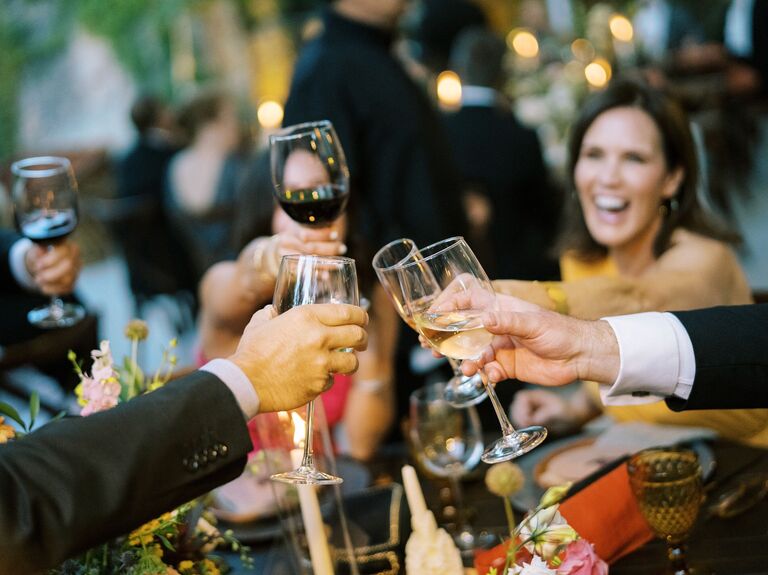What Is a Micro-Wedding? How to Decide if the Small-Scale Celebration Is Right for You

One trend that has been steadily on the rise over the last few years: downsizing your wedding. Micro-weddings, minimonies and elopements are more popular than ever, but what's the difference between them? We're explaining everything you need to know about planning a micro-wedding—and what makes it the perfect compromise between an elopement and a full-blown wedding. At a glance, a micro-wedding is fundamentally smaller in guest count compared to a regular wedding, but hiring a full team of wedding vendors is still part of the process. Keep reading for our in-depth explanation of what is considered a micro-wedding, plus a helpful micro-wedding timeline to follow when you're starting to plan.
Micro-Wedding Planning Tips: Definition | Guest Count | Cost | Vendors | How to Plan
What Is a Micro-Wedding?
Like its name suggests, a micro-wedding is a smaller version of a 'regular' wedding, typically with a guest list of no more than 50 people—usually immediate family and super-close friends only.
Though tiny in guest count, a micro-wedding is still big on style and usually involves a full team of vendors providing decor, flower arrangements, catering, music and photography. You can think of a micro-wedding as something in-between a big, traditional wedding and an elopement (more on this in a minute). Micro-weddings are for couples who don't necessarily want a big event with hundreds of guests, but they don't want to compromise on experience or smaller details, either. "Planning a micro-wedding encourages couples to prioritize what's most important to them and how and what they want to spend their time and money on," says Lauren Miller, owner of Tiny Wedding Co., a Washington, DC-based event company that specializes in planning micro-weddings. "Oftentimes, this means a more thoughtful event with intimate and sentimental details."
And while a micro-wedding can help you save money in some ways, it's not about cutting corners. Instead, many couples use the lower guest count to maximize their budget and splurge on things like a top-shelf open bar, a unique venue or amazing entertainment. With a guest list of just a few dozen people, a tropical destination weekend wedding, a designer wedding dress or a decadent brunch at a five-star restaurant becomes much more feasible.
What is a minimony?
A minimony is a short, simple ceremony shared between yourselves or in the company of your closest loved ones—usually no more than 10 people. Similar to a civil ceremony, a minimony is primarily a legal commitment ceremony, with less of a focus on planning a big reception afterward. Although minimonies are often followed by a small dinner or meal, the decor and entertainment are usually much more downsized compared to a micro-wedding or traditional wedding. This could mean working with a smaller team of vendors for just the basics, like hiring a pastry chef for a miniature cake or enlisting a florist to design a few flower arrangements. Some couples choose to hold a minimony as their private ceremony, followed by a larger reception or party at a later date.
Elopement vs. micro-wedding
Traditionally, elopements were considered spur-of-the-moment and unplanned events involving an element of secrecy. Today, elopements are small, super-intimate ceremonies, such as a courthouse wedding or scenic outdoor vow exchange. Elopement ceremonies are usually performed by a legal representative (like a court clerk) or a nondenominational wedding officiant. Unlike micro-weddings and minimonies, elopements generally don't include a group of guests. At most, elopements involve one or two witnesses, depending on the legal requirements where you're getting married. Elopements aren't followed by big receptions or parties, either, although you might choose to plan something with friends and family a few weeks or months later.
When you're weighing the choice between an elopement vs. a micro-wedding, think about what's most important to you. If you want the chance to celebrate with your loved ones on the actual day, or if you like most aspects of a traditional wedding—except with fewer people—then a micro-wedding would make sense. If you and your partner would rather skip the process of inviting guests and planning a reception, then an elopement or a minimony could be a better fit.

Micro-Wedding Size: How Many Guests?
So, how big is a micro-wedding? There isn't an exact number that qualifies an event as a micro-wedding, but the guest count is definitely less than a typical wedding. "We define a micro-wedding as having 50 guests or fewer," says Miller. "A guest count beyond that would be considered a regular-sized wedding." According to The Knot Real Weddings Study, the average wedding size in 2023 was 115 guests. In comparison, events with 50 to 100 people are often referred to as small weddings (a step up from micro).
Making the guest list for your micro-wedding forces you to be very selective about who you invite and you might have to set ground rules around inviting plus-ones, kids or extended family, but the smaller micro-wedding size has benefits, too. Having fewer people present can take some of the wedding day pressure away from you and your partner—and you'll have a better chance of actually spending time with everyone.
Micro-Wedding Cost
Just like any other wedding, how much your micro-wedding costs will depend on your wedding date, venue and priorities. Yes, a micro-wedding has fewer guests than other weddings, but that doesn't necessarily make it less expensive, especially if you're adding bespoke details or splurging on certain vendors. Making (and sticking to) your wedding budget is just as important as ever when you're planning a micro-wedding—the main difference is that when hosting a smaller group, your dollars will potentially stretch further. To put it into context, the average wedding cost in 2023 was $35,000, according to The Knot Real Weddings Study. If you take that budget and apply it to a group half the size of the average wedding (as a reminder, it's 115 people), you're working with more funds per person to cover catering prices, open bar tabs, travel accommodations, wedding favors and more. "Our couples save anywhere from $15 to $40K by having a micro-wedding," says Miller.
But as the saying goes, time is money—and for some couples planning a micro-wedding, saving time is even more important than saving money, Miller says. All-inclusive micro-wedding packages that include event coordination, photography, floral design and are a big time-saver, according to Miller. "It cuts way back on the amount of back-and-forth communication needed to book a wedding vendor," she says. "On average, we'd guess that our couples save about 15 hours in vendor research, email and phone communication, and contract negotiation right off the bat." A final bonus? When you opt for an all-inclusive package, Miller says that it helps avoid feeling overwhelmed or struggling with decision fatigue, which helps simplify the entire process.
How to Find Micro-Wedding Vendors Near Me
Don't let the 'micro' part fool you—pro vendors are still a big part of bringing your micro-wedding to life. Remember: this downsized event is all about maximizing personal details and elevating the overall experience for your guests, so it's important to lean on professionals who can make it happen (and take away the stress of doing things on your own).
Finding the right micro-wedding venue is an obvious one, but you'll also need a micro-wedding photographer and a micro-wedding planner who have experience with these smaller types of events. Depending on the rest of the details, you'll also want to hire a florist, wedding cake baker, live musician or DJ, hair and makeup artists and a wedding caterer (unless the venue is a restaurant). You can find all of these vendors—and more—using The Knot Vendor Marketplace. Start by searching for micro-wedding venues near you or other vendors by category in your wedding location, then use the filters to sort the results by budget, guest count, vendor diversity and award winners, like The Knot Best of Weddings or Hall of Fame.
How to Plan a Micro-Wedding
The basic process for how to plan a wedding doesn't change too much when you're planning a micro-wedding, but it all depends on how soon you're getting married. While the average engagement length is 15 months, many couples plan their micro-wedding in a shorter time frame. "Our average lead time for a micro-wedding is about six to eight months," says Miller. "Micro-weddings without guests or an actual venue (like a ceremony that takes place in a public park) are a lot easier and faster to plan than, say, a sit down dinner at a restaurant or a reception with dinner and dancing at a venue." Here's our recommendation of how to plan a micro-wedding in chronological order.
1. Think about your wedding vision.
Before you really get into the deep end of micro-wedding planning, think about the big picture first. What's your overall vision for the day? What are your priorities, or what are you okay with skipping? Set aside time with your partner to make a list of your must-haves and wedding mission statement, such as getting married in a specific location, serving a specific type of food or how you want to decorate. If you're not sure where to begin, start by taking The Knot Style Quiz or browsing the latest wedding trends. You can even start working on a wedding mood board to share with your vendors.
Once you've decided to have a micro-wedding, you can start to share your plans with close loved ones—but don't be discouraged if they don't fully see the vision at first. "Your family and friends may not agree with your plans to have a micro-wedding, and that's okay," says Miller. "There can be an enormous amount of pressure from loved ones (and social media!) to do things a certain way. Some folks are offended by the lack of 'tradition' or your decision to cut certain family members from the guest list. Have a conversation with your partner before these opinions surface so that you can approach them together firmly but with love."
2. Discuss your budget.
Setting a budget is an important part of planning a wedding, no matter where you're getting married or how many people are invited. You shouldn't move forward with any official decisions until you know how much you can spend, so discuss what you can realistically afford with your partner and be sure to include anyone else who has offered to contribute money toward your wedding. Once you have a ballpark number, decide how you'd like to allocate your budget based on what's most important to you. And when you're done crunching numbers, The Knot Budget Advisor is a free estimator that helps you plan your wedding expenses based on what real couples spend in your marrying location.
3. Finalize your guest count.
With your budget in place, you'll have a better idea of how many people you can invite to your micro-wedding without cutting corners or compromising on what you really want. A four-course catered dinner party might be out of reach if you were to invite 150 guests, but if you're only inviting 30 or 40 people, chances are it's more within budget. It's also important to have your guest count (or a rough guest list) finalized before you start touring venues for a micro-wedding—the next step on your checklist.
4. Set the date and choose a venue.
When you're celebrating with a smaller group, your venue options can go beyond the types of spaces you'd be limited to in order to accommodate hundreds of guests. An intimate party for 20 people at your favorite fancy restaurant? No problem. An exclusive reception at a private waterfront rental home? Much easier to coordinate if you're only inviting 35 guests. Think outside the box when you're browsing and touring small wedding venues, and don't feel like you have to limit yourself to getting married on a weekend, either. Another perk of hosting a micro-wedding is that you can get married on a weekday without causing as much of an inconvenience for too many people.
5. Build your wedding website and registry.
Even if you're ditching other wedding traditions, creating a wedding website and wedding registry are two things you don't want to skip. Despite your smaller guest count, people will still need to know the basic details of the day—and they'll still want to celebrate the occasion with a special gift. Choose a wedding website template that feels appropriate for your vibe and start making your wedding registry, even if you're more interested in building a cash fund or registering for honeymoon experiences.
6. Send save-the-dates and invitations.
Yes, you should send save-the-dates and invitations even if you're planning a micro-wedding. In fact, your wedding stationery is one element where you can consider splurging in ways that you wouldn't always be able to do with a larger guest count. Shop for easy micro-wedding invitations on The Knot, or put your budget toward designing a custom invitation suite with elevated details like handwritten calligraphy, personalized illustrations or paper upgrades. Save-the-dates are typically sent about eight months before the wedding and invitations are sent around two months prior, but you may need to adjust the timing depending on how soon you're getting married.
7. Add bespoke upgrades.
This is arguably one of the best parts of your micro-wedding checklist, because it's much easier to incorporate bespoke details and unique activities when you're hosting a smaller group. Focus on small wedding ideas, like handwritten dinner menus or individually boxed desserts, that are simple but will upgrade the experience for everyone. And you can make the experience even more memorable by incorporating details and activities that you really love, even if they go against wedding norms or break with tradition. "With wedding inspiration at the tip of our fingers via social media, it's easy to get caught up in expensive trends and over-the-top decor and budgets," Miller says. "I love seeing couples spend their day doing what they love with the people they love—not living out somebody else's wedding they saw on Pinterest."
Not big on dancing or asking your loved ones to give public speeches? Skip them in place of another activity instead. Hire an olfactory expert to blend custom perfumes for each guest, curate luxury welcome packages for a destination wedding or enlist artisan vendors to design one-of-a-kind items for people during the reception, like embroidered apparel or made-to-measure cowboy hats. Don't be afraid to think outside of the box for your micro-wedding, and always prioritize what authentically speaks to you and your partner.
























